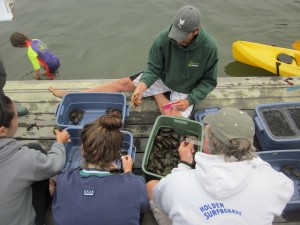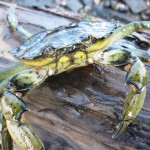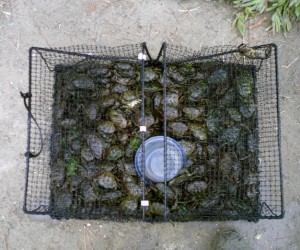by Monaca Noble
On a thin strip of land between Bolinas Lagoon and the Pacific Ocean lies the neighborhood of Seadrift, a community battling an invasion of crabs that have taken over their lagoon.
Seadrift is a small subdivision at the northern tip of Stinson Beach, Calif., sandwiched between Bolinas Lagoon and the Pacific Ocean on a narrow sand spit. It surrounds a small enclosure called the Seadrift Lagoon, an artificial lagoon created for the subdivision. It’s a popular site for visitors, and the lagoon provides recreational enjoyment for the entire community. But for the last two decades one unwelcome visitor has proven to be very bad company.
In the early 1990s, the European Green Crab (Carcinus maenas), took up residence in both Bolinas and Seadrift Lagoons. European Green Crabs are native to Western Europe and Africa but have invaded many regions around the world, reaching high population densities in parts of their invaded ranges. They are highly adaptable, voracious predators that consume animals and plants in the intertidal area. Their diet includes commercially important species such as oysters, clams, and small Dungeness crabs, as well as other native shore crabs and clams important for migratory shorebirds. Green crabs became established in San Francisco Bay around 1989 and spread south to Elkhorn Slough, Calif., and north to Vancouver Island, British Columbia. Their spread along the west coast is due in part to the ability of their small planktonic larvae to move along the coast in the currents.
In Seadrift their impacts are unmistakable. The green crabs have all but driven out native crab species, leaving few native crabs, other large invertebrates or fish. Seadrift Lagoon hosts the highest density of green crabs along the U.S. west coast and may have a hand in spreading their larvae to the rest of Bolinas Lagoon and nearby bays and estuaries. By reducing Seadrift Lagoon’s green crab population, we hope to reduce predation on native species and reduce the supply of green crab larvae able to invade other sites.
See also: As green crabs invade, Alaskans launch counteroffensive >>
Since 2009 researchers and volunteers have been working together to remove the invasive crabs. Volunteers venture out into the lagoon during three consecutive seasons, rain or shine, in hopes of trapping them. Collapsible traps are baited and laid across six transects (each approx. 150 m long), with three transects on each side of the lagoon – totaling 90 traps a day. When the traps are collected the following day, crabs are bagged, frozen and donated to Gospel Flat Farm, a local farm in Bolinas where they become compost. According to the owners, green crabs make excellent crop fertilizer, thanks to the large amounts of calcium in their exoskeletons and nitrogen in their tissue.
The researchers come from the Smithsonian Environmental Research Center (SERC), Portland State University and the University of California, Davis. The team of volunteers includes students, local homeowners like Gail Graham and other concerned residents like Kiren Niederberger, the manager of the Seadrift Association.

SERC Marine biologist Chris Brown (green shirt) helps volunteers sort green crabs trapped in the day’s catch. (SERC)
“Volunteering to help with the European Green Crab removal from the Seadrift Lagoon was like a combo history and marine biology lesson,” says Graham.
Since 2009 we have removed over 57,600 crabs from the lagoon and have seen a significant decrease in our catch per unit effort, indicating some success in bringing down the population. In the first year volunteers and staff removed over a third of the green crabs in the lagoon. Over the three-year sampling period, the number of crabs caught per trap dropped considerably, from an average of 25 in 2009 to 8 in 2011. We have also seen an increase in the abundance of juvenile native crabs, so even without full eradication, some recovery of native species has occurred. This project demonstrates that small eradication may be possible in localized areas, such as small (new) isolated invasions.
Trapping will resume in Spring 2012. If interested in volunteering or for more information about the project, contact Chris Brown at browncw@si.edu, (415) 435-7128.




Its awesome what you guys are doing for Seadrift. I can only imagine what a task it is removing these crabs. Wish I had the time to volunteer as well. – Mike